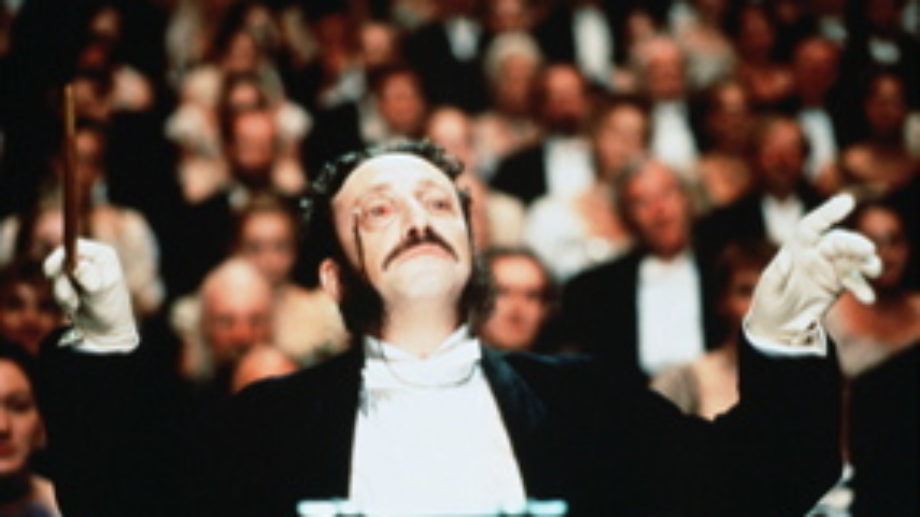
A couple of weeks ago, before the opening ceremony of the London Olympics, I asked myself, as any cinephile would: what other British filmmakers could’ve directed the opening ceremony and what would it have been like? After my mind jumped through a cinematic rolodex, from Andrea Arnold to Michael Winterbottom, I realized what a fool I was for having forgotten quite possibly the most important one of them all: Mike Leigh. No other living filmmaker is more readily associated with the city and to those who think that Leigh’s take on the opening ceremony would’ve been a drab, depressing affair, they needn’t look further than his 1999 film, Topsy-Turvy.
Clocking in at about 160 minutes, Leigh’s rip-roaring musical comedy is about as long as the ceremony itself and similarly, it covers a bit of British history. As we learn, the film's opening scene is set in London on January 5th, 1884. Such a specific date is the product of historical fact; it is on that very day that legendary stage collaborators W.S. Gilbert and Arthur Sullivan opened Princess Ida, one of their many inspirational comic operas, which, at the time, was a commercial failure and the impetus of a temporary creative standstill between the two.
As deeply rooted in history as it is, Topsy-Turvy is as much connected to the struggles of any creative artist and seemingly Leigh's own creative frustrations. Upon first meeting Gilbert and Sullivan in the film, it’s clear that Leigh has essentially parted the two spectrums of creative beings. Gilbert, an irascible man, fiercely responds to critics who call him “the legitimate monarch of the realm of topsy-turvydom,” but refuses to accept it and feels no need to alter his artistic vision. To him, any criticism is the product of misunderstanding of his work.

Sullivan takes himself just as seriously as Gilbert, but his artistic drive is fueled not only by his own aspirations but also by the criticisms leveled against his work. When he refuses to write another opera with Gilbert in order to work on more high-minded pieces, his reasoning is because “people expect it of me and I must not disappoint them.”
By dissecting the creative mind, the film is able to stand outside the argument between Gilbert and Sullivan while somehow inversely appeasing both concerns. Heavily criticized for the bleakness of his films, Leigh seems to do as Gilbert does by delivering a work directly resulting from such opinions. Bursting with ornate set design, comic-opera numbers, and a deft sense of humor, the film is nearly irresistible. Even the basic description of the film—a musical-comedy set in Victorian era London—is inherently pleasing in a way.
Yet, Leigh—just as Gilbert does—maintains his vision, albeit in measured doses as opposed to his other films. Beneath the razzle-dazzle of Topsy-Turvy is a tender depiction of just how much work goes into relationships, both professional and personal. Take a scene between Gilbert and his wife, played by Lesley Manville. As Mrs. Gilbert sits cooped up in her bed, her husband sits at a distance in his chair, opining about the failure of Princess Ida. Frustrated, he gets up to leave—to sleep in his own bed—but Mrs. Gilbert asks him to sit on her bed and talk with her. Caught up in his own thoughts, Gilbert deadpans, “one wonders why one bothers.”
As with most of his work, Leigh's writing is both precise and verbose, maybe even more so than usual in this film due its focus on high-class Londoners during a time when European fascination caused people to proudly speak in a variety of tongues from one second to the next. Yet when such verbal agility is reined in, as with the scenes with Gilbert and his wife, the opposite is in effect. Whether it's the theatrical performances themselves or any of the frenzied, dictionary-demanding scenes, we are able to keep pace, both narratively and emotionally. The quiet exchanges between the Gilberts, and other scenes such as those, offer a level of unspoken worriment rather than the rather direct nature of the rest of the film. Such a dichotomy reveals a foundational concern regarding Leigh's thoughts on human connection: how can we be so confidently eloquent in the more public arenas in life, yet so helplessly inarticulate in our most personal moments?
Combine tonight's screening of Topsy-Turvy with a meal at Indie Food and Wine in our Film Center with our unbeatable Dinner and a Movie deal for just $25! And make sure to check out the rest of the 50 Years of the New York Film Festival lineup, including next Tuesday's screening of Terence Davies' The House of Mirth (NYFF '00), films by Pedro Almodóvar, Lars von Trier, and more!
Below is a list of films that played alongside Topsy-Turvy in NYFF '99:
All About My Mother
Pedro Almodóvar, Spain, 1999.
Felicia's Journey
Atom Egoyan, UK/Canada, 1999.
Beau travail
Claire Denis, France, 1999.
Being John Malkovich
Spike Jonze, USA, 1999.
Boys Don't Cry
Kimberly Pierce, USA, 1999
The Carriers Are Waiting
Benoît Mariage, Belgium/France, 1999.
The Color of Paradise
Majid Majidi, Iran, 1999.
Dogma
Kevin Smith, USA, 1999.
Holy Smoke
Jane Campion, Australia, 1999.
Juha
Aki Kaurismäki, Finland, 1999.
julien donkey-boy
Harmony Korine, USA, 1999.
The Letter
Manoel de Oliveira, France/Portugal, 1999.
License to Live
Kiyoshi Kurosawa, Japan, 1999.
Mobutu, King of Zaïre
Thierry Michel, Belgium, 1999.
The Other
Youssef Chahine, Egypt/France, 1999.
Pola X
Leo Carax, France, 1999.
Princess Mononoke
Hayao Miyazaki, Japan, 1999.
Pripyat
Nikolaus Geyrhalter, Austria, 1999.
Rien sur Robert
Pascal Bonitzer, France, 1999.
Rosetta
Jean-Pierre and Luc Dardenne, Belgium, 1999.
Set Me Free
Léa Pool, Canada/Switzerland, 1999.
Sicily
Jean-Marie Straub and Danièle Huillet, France/Italy, 1999.
Time Regained
Raúl Ruiz, France, 1999.
The Woman Chaser
Robinson Devor, USA, 1999.



